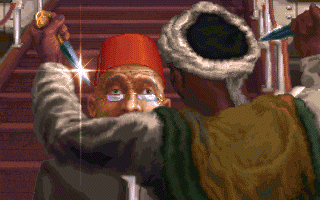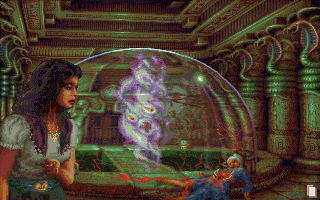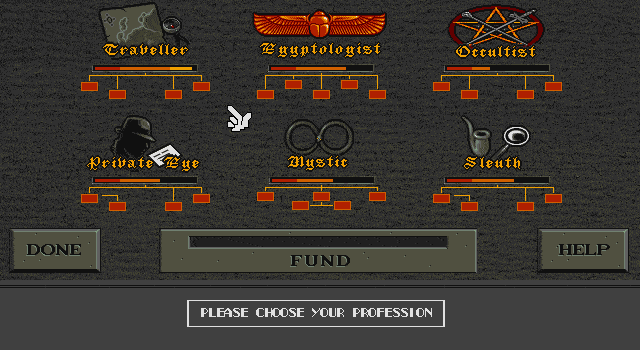Daughter of Serpents (1992)
In which I take a look at Daughter of Serpents, a vaguely Lovecraftian adventure game from 1992 and its companion lightweight story-forward TTRPG.

Thanks to friend of the blog Chris Salzman, I read a nice article on Genesis Temple about a curious pair of adventure games from the early 90s—as the gaming world transitioned to the hitherto unknown heights of storage known as the CD-ROM. I encourage you to read that Genesis Temple article for more details on that era.
The game said article focused in on was originally called Daughter of Serpents and it is:
- A mysterious adventure,
- Set in 1920s Egypt, and
- Vaguely Lovecraftian in tone.
And if that weren’t enough, the video game apparently came with a small zine-scale tabletop roleplaying game system and prequel scenario. "I feel personally attacked." I knew I had to track this down and play it immediately, regardless of whether or not it was any good. As a spoiler: I wish I could tell you the video game is a forgotten gem.
Daughter of Serpents (I could not, alas, get the remixed CD-ROM version called The Scroll to run on my Mac) is a short little game that sees the player delve into a mystery in Alexandria in the early 1920s. The backstory is intriguing—relics are being smuggled and strange doings are afoot—and the graphics are lovingly rendered. The music is peppy in that ol' DOS soundblaster style. There is a ridiculously overblown—if delightful—character creation system, letting you play as a character with a wide range of skills from "egyptology" to "divination." Unfortunately, the game itself doesn’t really ask the character—or the player, sadly—to really use those skills. The game is more of an interactive novel: you visit a scene, you find a couple things to click on, you watch some dialogue. There are minimal branches in the dialogue and almost no real choices to make in moving the story forward. You can die at several junctures, which adds an element of spicy danger to the mix, but the UI is bafflingly antagonistic to the player—you can’t reload a save game without starting the game over again and sitting through the introductory sequence, then operating the clumsy inventory system to find the “load a save file” option.



But it is atmospheric and the story is nicely done and well paced. It certainly doesn't overstay its welcome: the entire experience can be had in a couple of hours. It gives strong “Masks of Nyarlathotep Side Quest” vibes. If you’d like to play it on a modern Mac, you can do so via Boxer (make sure you get the newer beta version) and the floppy disc version is available here. If you’re on a PC, this might be your plug.
I rate it a C.
So much for the video game. Let’s talk about the TTRPG!
A TTRPG? Included in my 1990s Adventure Game?

Now this is a forgotten gem that can be found on RPGGeek (along with some supporting material like a character generator). If you’re interested in story games, investigative RPGs, or RPG history, I think you'll get a kick out of this.
Firstly, it is very up front—especially for 1992—in placing itself firmly in the narrativist RPG camp. It eschews complex rules in order to focus on what it asserts all RPGs ultimately are: interactive storytelling experiences. It even positions the “GM” as “the Director” and rather than allotting them “mastery” over the world and the story, it suggests that their principal role is to be flexible, keep the game moving without stressing about rule details, and to try to facilitate everyone having a fun time at the table.
It's very easy to get bogged down in the mechanics of RPGs, with piles of weird shaped dice, and towers of rulebooks, but whatever the differences between systems, all are fundamentally the same. The answer to the question 'what are role-playing games?' is simple - they are interactive storytelling.
As for the system itself, it has a handful of professions apropos to a 1920s-era investigative / mythos-y game: Traveller, Egyptologist, Sleuth, Private Eye, Occultist, Mystic. It distributes skills amongst the professions, but adds that characters can take skills from outside their professions if they so choose. The professions seem more like a way to divvy up spotlight moments. Resolution mechanics are straightforward: skills are rated from 1 to 4, the number indicating how many dice you roll when testing your skill. You’re looking to meet or exceed a target number set by the Director by adding your dice results together. The higher you roll, the better. Character advancement is based on collecting checkmarks next to skills you’ve tested during the game—every fifth successful test, you get better at that skill.
And that’s pretty much it, modulo some more story-forward reminders—the entire system fits on 7 small booklet-sized pages. A couple pages of RPG tips and Directorial Advice, and the rest of the booklet is a scenario to play.
Thoroughly charming, and it feels almost like something that would have come out of the OSR or Story Games / Forge movements. It reads like something I might play today, given a slightly different coat of paint.
I’m really glad I found this. B+.



Comments ()